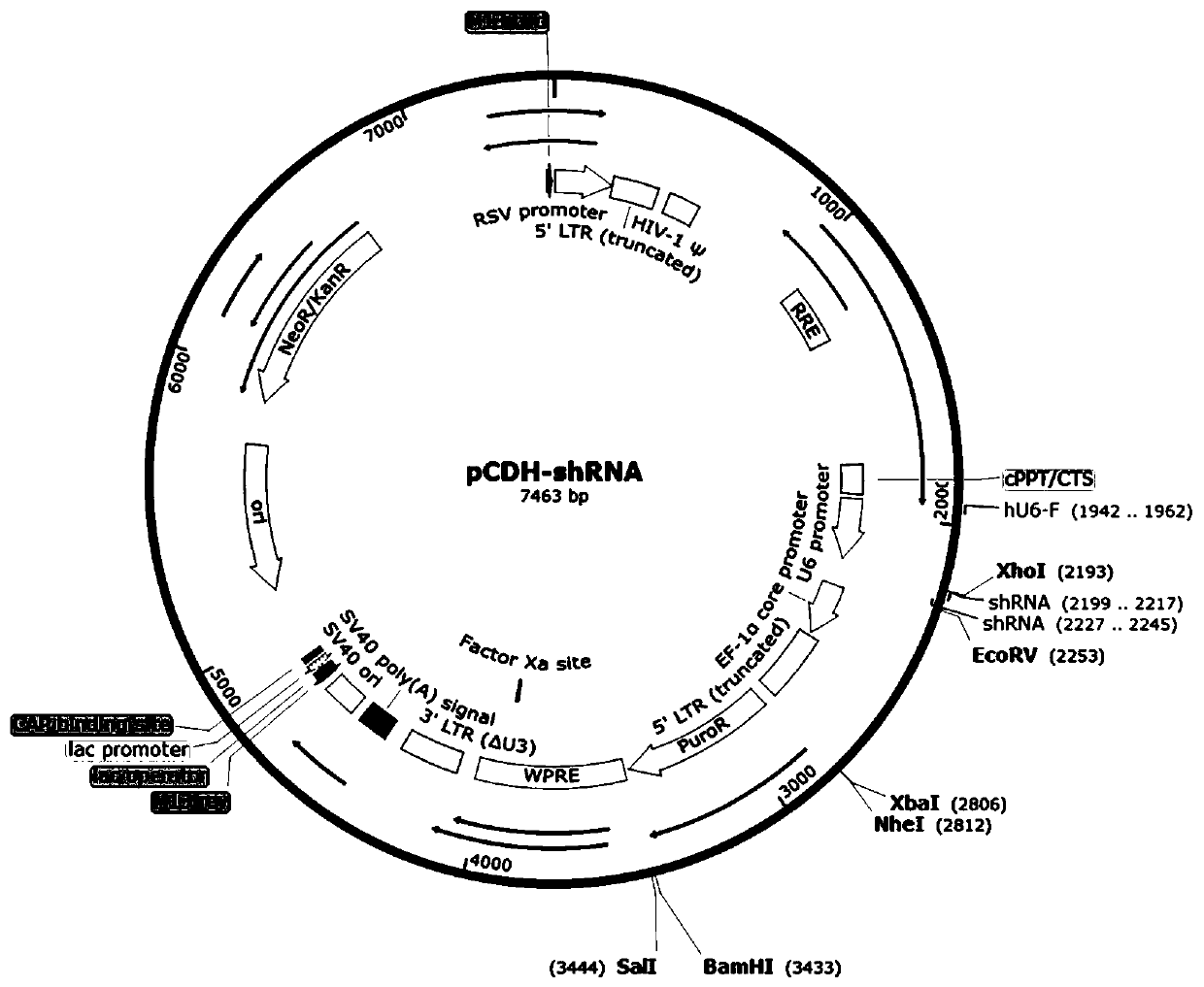ShRNA of CXCR4 gene and application of shRNA
A gene and expression vector technology, applied to the shRNA of the CXCR4 gene and its application fields, can solve problems such as the difficulty of human T cells
- Summary
- Abstract
- Description
- Claims
- Application Information
AI Technical Summary
Problems solved by technology
Method used
Image
Examples
Embodiment 1
[0078] siRNA and shRNA sequence design of embodiment 1 CXCR4 gene
[0079] The full-length mRNA sequence of the CXCR4 gene published by GenBank (NM_003467.2) was analyzed, the specific mRNA was obtained by Blast comparison, and the siRNA of CXCR4 mRNA was designed. The target position of each siRNA was as follows: figure 1 The specific sequence information is shown in Table 1.
[0080] Table 1 6 specific siRNAs of CXCR4 gene
[0081] serial number target nucleotide sequence target position SEQ ID NO:1 gcaaggcagtccatgtcatct 421~441 SEQ ID NO:2 ggatcagcatcgactccttca 868~888 SEQ ID NO:3 gcacatcatggttggccttat 701~721 SEQ ID NO:4 agataactacaccgaggaaat 122~142 SEQ ID NO:5 cctgttcttaagacgtgattt 1512~1532 SEQ ID NO:6 tcctgtcctgctattgcatta 739~759
[0082] According to the siRNA sequence, design the corresponding shRNA, the shRNA includes the sense strand (S) and the antisense strand (A), the shRNA sequence is composed...
Embodiment 2
[0086] The construction of the shRNA lentiviral expression vector of embodiment 2 CXCR4 gene
[0087] The pCHD vector was double-enzymatically digested with XhoI / EcoRV, and recovered by gel cutting; primer annealing was completed by designing specific primers based on shRNA; the shRNA and the recovered vector were recombined to form circular fragments, and transformed into the prepared bacterial competent cells , select a single clone colony for sequencing identification, and the correct clone is the successful construction of the shRNA silencing vector.
[0088] Specific steps are as follows:
[0089] (1) Double enzyme digestion of the vector
[0090] ① Cultivate the cloning strain containing pCDH empty vector overnight, take 5mL of fresh bacterial liquid and use QIAGEN plasmid extraction kit to extract the plasmid;
[0091] ②Take 2 μg of the extracted pCDH, and digest it with the corresponding restriction endonuclease at 37°C for about 1 hour. The enzyme digestion system i...
Embodiment 3
[0112] Example 3 lentiviral packaging
[0113] The lentiviral vector constructed in Example 2 was packaged with lentivirus, using a four-plasmid system, and the specific steps were as follows:
[0114] (1) The four-plasmid system includes gag / pol, Rev, VSV-G and lentiviral vector pCDH-shCXCR4-1-6 or negative control plasmids required for packaging lentiviral vectors. Add the above plasmids to a certain volume of serum-free DMEM In the culture medium, place it for 15 minutes after mixing;
[0115] (2) Add the above mixture into a T75 culture flask lined with 293T cells, mix gently, and transiently transfect 293T cells, at 37°C, 5% CO 2 Cultivate in a cell incubator for 6 hours;
[0116] (3) Replace the fresh medium after 6 hours, continue the culture, and add 10 mM sodium butyrate solution, and collect the culture supernatant after 72 hours for lentivirus purification and detection.
PUM
 Login to View More
Login to View More Abstract
Description
Claims
Application Information
 Login to View More
Login to View More - R&D
- Intellectual Property
- Life Sciences
- Materials
- Tech Scout
- Unparalleled Data Quality
- Higher Quality Content
- 60% Fewer Hallucinations
Browse by: Latest US Patents, China's latest patents, Technical Efficacy Thesaurus, Application Domain, Technology Topic, Popular Technical Reports.
© 2025 PatSnap. All rights reserved.Legal|Privacy policy|Modern Slavery Act Transparency Statement|Sitemap|About US| Contact US: help@patsnap.com



